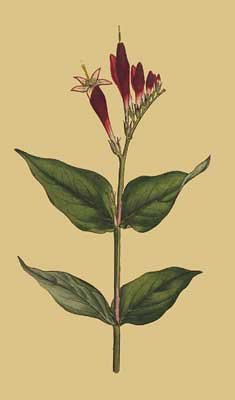Spigelia Marilandica
Flowers

Spigelia Marilandica
This plant, not less celebrated for its superior efficacy in destroying worms, than admired for its beauty, is a native of the warmer parts of North America, the older Botanists, and even Linnaeus, at one time considered it as a honeysuckle, but he has now made a new genus of it, which he has named in honour of Spigelius, a Botanist of considerable note, author of the Ifagog. in yem herbar. published at Leyden in 1633.This plant is not easily propagated in England, for the roots make but slow increase, so that the plant is not very common in the English Gardens at present, for although it is so hardy as to endure the cold of our ordinary winters in the open air, yet as it does not ripen seeds, the only way of propagating it is by parting of the roots, and as these do not make much increase by offsets, so the plants are scarce, it delights in a moist soil, and must not be often transplanted. Millers Dict.The scarcity of this plant, even now, is a proof of the justness of Mr. Millers observation, it is in fact a very shy plant, and scarcely to be kept in this country but by frequent importation.It flowers in June and July.
 Convolvulus Purpureus
Convolvulus Purpureus Hyoscyamus Aureus
Hyoscyamus Aureus Erica Grandiflora
Erica Grandiflora Amaryllis Atamasco
Amaryllis Atamasco Blitum Virgatum
Blitum Virgatum Lilium Candidum
Lilium Candidum Narcissus Incomparabilis
Narcissus Incomparabilis Centaurea Glastifolia
Centaurea Glastifolia Lachenalia Tricolor
Lachenalia Tricolor Aster Tenellus Bristly leavd Aster
Aster Tenellus Bristly leavd Aster Pelargonium Tetragonum
Pelargonium Tetragonum Saxifraga Sarmentosa
Saxifraga Sarmentosa Test your English Language
Test your English Language  Precautions while using Cathode Ray Oscilloscope
Precautions while using Cathode Ray Oscilloscope Global Dial Code
Global Dial Code IBPS Exams
IBPS Exams Benefits of Tamarind
Benefits of Tamarind Sunil Gavaskar
Sunil Gavaskar The Crocodile and Monkey
The Crocodile and Monkey Precautions while using Kitchen Equipments
Precautions while using Kitchen Equipments




